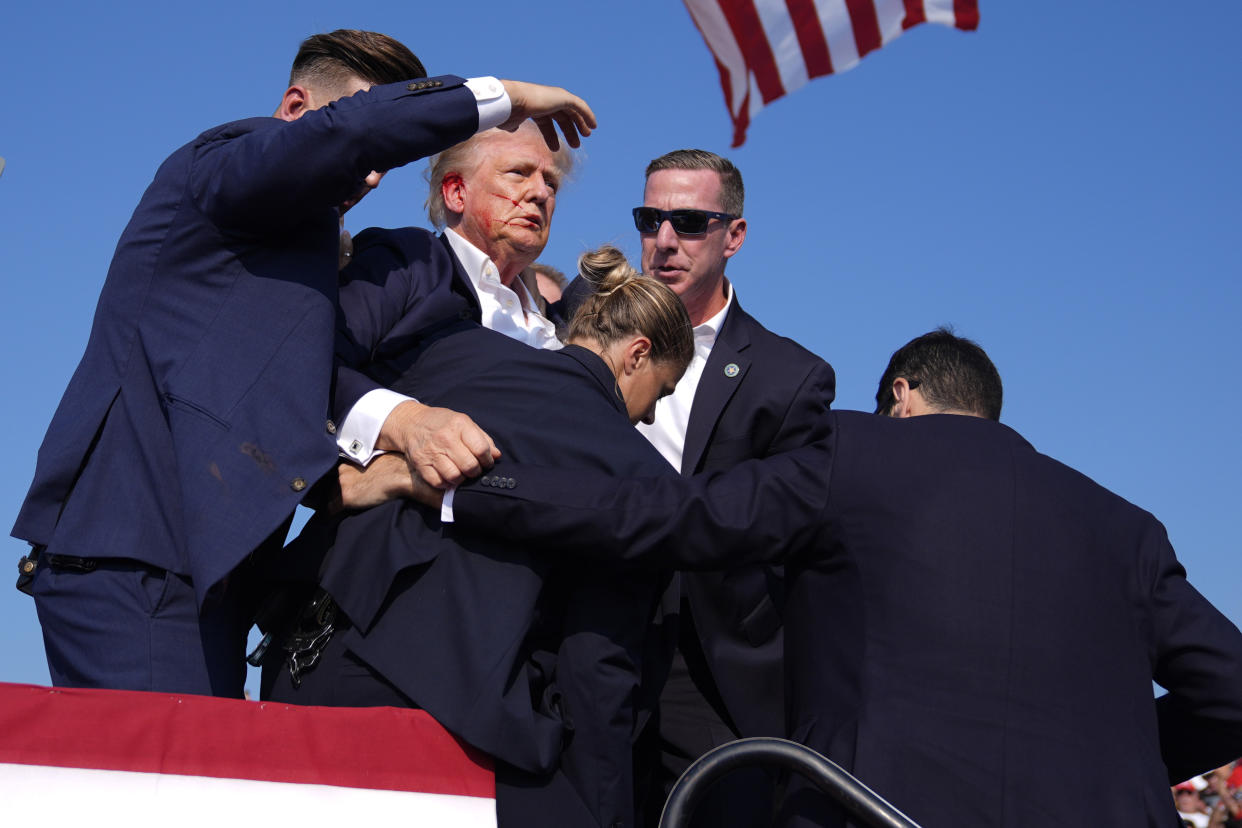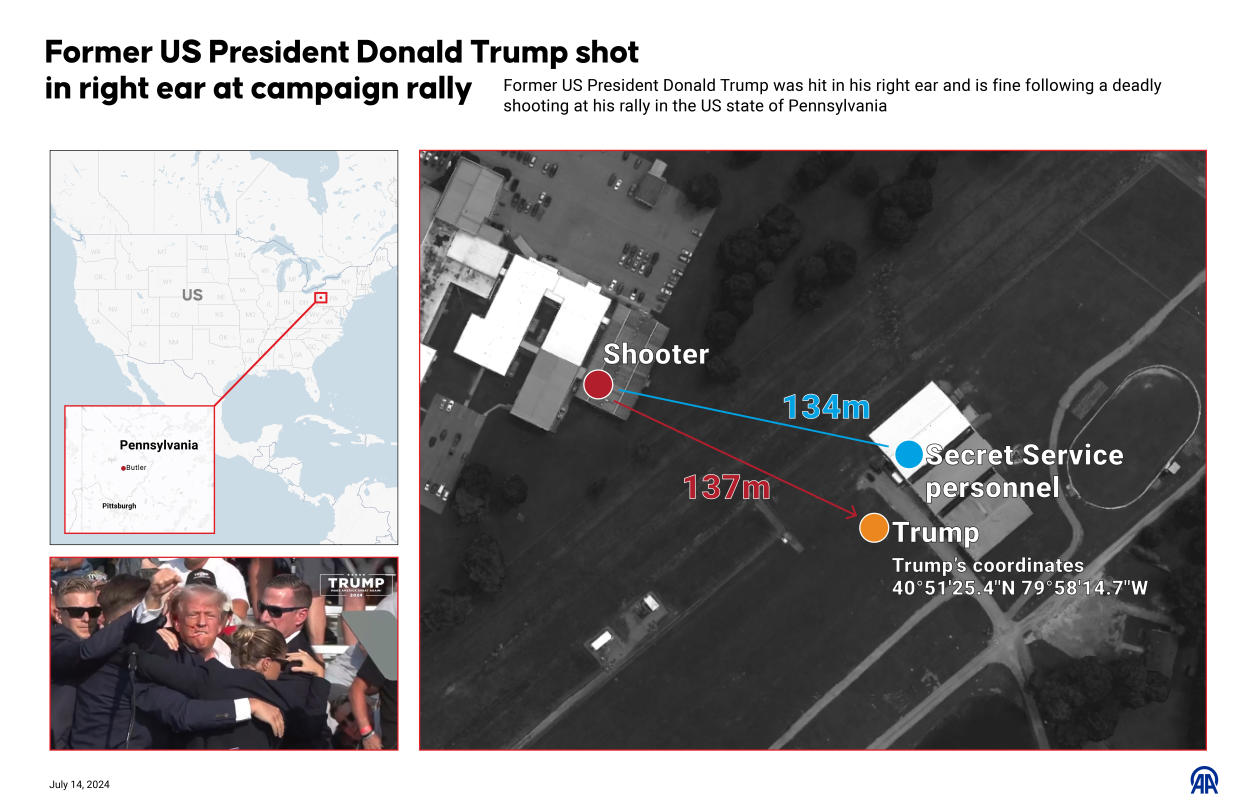Trump rally shooting: What was the shooter's motive? How did he get so close? Six unanswered questions

The attempted assassination of former President Donald Trump at his campaign rally in Butler, Pa., on Saturday marks the first time in 43 years such a threat was made on a former or current U.S. president’s life.
The FBI is leading the investigation into the shooting that left Trump wounded in the right ear — and killed Corey Comperatore, a 50-year-old former fire chief, and also wounded two spectators. The FBI identified the gunman as Thomas Matthew Crooks, a 20-year-old from Bethel Park, Pa.
U.S. House and Senate members received a virtual briefing from Secret Service and FBI officials Wednesday afternoon regarding the Trump rally shooting, as investigations open into what happened.
While a picture is starting to emerge, several key questions remain:
1. What was the shooter's motive?
An AR-15-style rifle recovered at the scene was legally purchased by Crooks’ father in 2013, according to multiple law enforcement sources.
The FBI and Department of Homeland Security said the gunman bought 50 rounds of ammunition on Saturday morning. Investigators found three explosive devices in his possession: two in his car and the other in his home.
Crooks had no known history of mental illness, according to the FBI. He worked as a dietary aid at a local nursing home and passed a background check, according to ABC News. Crooks graduated from a Pennsylvania high school in 2022, where he was described by former classmates as a “loner” and a “nice” guy. Another classmate told NBC News Crooks was “bullied so much in high school.” Crooks had been a registered Republican.
Crooks did not leave a manifesto, as some mass shooters do, and his social media presence was minimal, offering few clues for investigators trying to determine a motive. The FBI said investigators unlocked Crooks’ phone on Monday and were analyzing his electronic devices in an effort to learn more. According to ABC News, Crooks had searched for images of both President Biden and former President Donald Trump, as well as information about Trump's Pennsylvania rally and the Democratic National Convention in Chicago.
At Wednesday's briefing, officials reportedly told senators that Crooks has posted a message on a popular gaming platform, but investigators later said they believed that message to be a fake.
Read more from ABC News: 'Loner' and 'nice': Complex portrait of gunman in Trump assassination attempt emerges
2. How was the shooter able to get that close to Trump?

Law enforcement officials said the shooter was armed with a semi-automatic AR-style rifle when he opened fire from the roof of a shed, located around 147 yards away from Trump.
For reference, an AR-15 rifle has an effective range of 400 to 500 yards, according to a weapons expert interviewed by the Associated Press.
Homeland Security Secretary Alejandro Mayorkas, who oversees the Secret Service, called the security measures at Saturday’s incident a “failure” and said the shooter shouldn’t have had a “direct line of sight” on Trump in the first place.
That’s why the FBI, President Biden, DHS and Congress have launched several investigations into finding out how the gunman was able to gain access to a roof, despite the presence of federal and local law enforcement agencies.
3. Why was the rooftop not secured?
While the Secret Service takes the lead on security for these types of campaign events, it’s common for the agency to coordinate with local law enforcement agencies.
Saturday’s campaign rally security consisted of at least a dozen police officers and sheriff’s deputies who were helping the Secret Service and Pennsylvania State Police.
According to Secret Service Director Kimberly Cheatle, the Secret Service was responsible for securing the inner perimeter of the fairgrounds where the campaign rally was held, while the local police’s primary responsibility was securing the outer perimeter. The outer perimeter included the building where the gunman gained access to fire his weapon from the roof.
“There was local police in that building — there was local police in the area that were responsible for the outer perimeter of the building,” Cheatle said. But local law enforcement disputes that claim and told the New York Times that local officers were in an adjacent building.
“I think all law enforcement on site did everything that they could, especially the local law enforcement,” Butler County Sheriff Michael Slupe told the AP on Monday. “I hope they’re not made a scapegoat, because they did their job to the best of their abilities.”
When ABC News asked Cheatle why the rooftop of the building wasn’t secure, she answered: “That building in particular has a sloped roof at its highest point and so, you know, there’s a safety factor that would be considered there that we wouldn’t want to put somebody up on a sloped roof and so, you know, the decision was made to secure the building from the inside.”
The Secret Service director told CNN Tuesday evening that the agency is “solely responsible” for the implementation and execution of security at Trump’s Saturday campaign rally.
Cheatle is expected to appear before the House Committee on Oversight and Accountability on July 22. She says she does not plan to resign.
4. Witnesses appeared to warn law enforcement the shooter was on the roof. What happened?
Before the suspect gained access to the roof of the building, several crowd members reported to local officials that they spotted a man acting suspiciously near the magnetometers — the machines used to screen attendees for guns and weapons before they enter. At that point, local officials had apparently exchanged photos of the suspect.
According to several media outlets who did their own analysis of eyewitness videos, crowd members had spotted the suspect on the roof about two minutes before the shooting happened and frantically tried to warn police.
“The police are down there running around on the ground. We’re like, ‘Hey man, there’s a guy on the roof with a rifle,’” a witness, who called himself Greg, told BBC News. “And the police were like, ‘Huh, what?’ Like they didn’t know what was going on.”
Slupe said a Butler Township police officer encountered the gunman when another officer tried to hoist him on the roof in search of a suspicious person. The gunman then turned and pointed the rifle at the police officer, who then dropped back down for safety, which is why he was not able to neutralize the shooter before the shots were fired.
5. What happened in the moments leading up to the counter-sniper's shots?
John Miller, a former senior official for the FBI and New York Police Department, said on CNN that they still need more information on what the Secret Service counter-sniper experienced leading up to killing the gunman.
“The counter-sniper appears to be looking through his scope as if he's scanning for something. … And then, when the shots are fired, takes out the shooter from his position almost immediately,” Miller said. “So we have to fill in those gaps. What happened during those seconds? What were the communications? What did he see through the scope, and did he act at his first opportunity? And we'll learn that later.”
Two federal law enforcement officials who had insight into the security response to the rally shooting told CBS News that the counter sniper who killed the gunman was assisted by a spotter.
6. How wide were the security gaps?
Before a high-profile person like Trump attends an event and needs Secret Service protection, the agency conducts a security survey that also takes nearby buildings into account.
William Pickle, a former special agent in charge of the Secret Service's vice presidential protection division who oversaw Vice President Al Gore’s detail, told USA Today that something was clearly missed. “We know who’s there, why they’re there, we have control over those buildings,” Pickle said. “It seems like somewhere in this security survey, someone dropped the ball on those particular buildings.”
Another expert told NBC News that outdoor rallies have immense security challenges, given the availability of high-powered weapons, like the AR-style rifle used in Saturday’s shooting.
“Let’s say you hunkered this whole area down. You’ve got the magnetometers; you’ve got the tactical element. Everything is locked and tight. How do you secure that outer perimeter? How far do you go? And can you cover everything? That’s a problem,” said former Secret Service agent Evy Poumpouras.
On Wednesday, law enforcement officials reportedly told lawmakers that Secret Service snipers saw the gunman 20 minutes before the first shots were fired, and had identified him as a suspect more than an hour beforehand.






